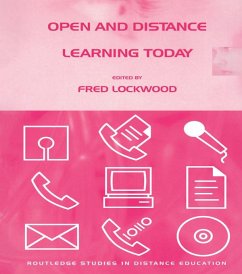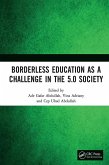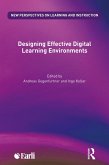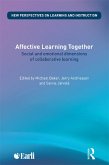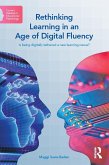Open and Distance Learning Today (eBook, PDF)
Redaktion: Lockwood, Fred
59,95 €
59,95 €
inkl. MwSt.
Sofort per Download lieferbar

30 °P sammeln
59,95 €
Als Download kaufen

59,95 €
inkl. MwSt.
Sofort per Download lieferbar

30 °P sammeln
Jetzt verschenken
Alle Infos zum eBook verschenken
59,95 €
inkl. MwSt.
Sofort per Download lieferbar
Alle Infos zum eBook verschenken

30 °P sammeln
Open and Distance Learning Today (eBook, PDF)
Redaktion: Lockwood, Fred
- Format: PDF
- Merkliste
- Auf die Merkliste
- Bewerten Bewerten
- Teilen
- Produkt teilen
- Produkterinnerung
- Produkterinnerung

Bitte loggen Sie sich zunächst in Ihr Kundenkonto ein oder registrieren Sie sich bei
bücher.de, um das eBook-Abo tolino select nutzen zu können.
Hier können Sie sich einloggen
Hier können Sie sich einloggen
Sie sind bereits eingeloggt. Klicken Sie auf 2. tolino select Abo, um fortzufahren.

Bitte loggen Sie sich zunächst in Ihr Kundenkonto ein oder registrieren Sie sich bei bücher.de, um das eBook-Abo tolino select nutzen zu können.
Fred Lockwood presents a comprehensive account of research and development in open, distance and flexible learning from a range of acknowledged experts from around the world. An essential purchase for teachers and students alike.
- Geräte: PC
- mit Kopierschutz
- eBook Hilfe
- Größe: 9.23MB
Andere Kunden interessierten sich auch für
![Borderless Education as a Challenge in the 5.0 Society (eBook, PDF) Borderless Education as a Challenge in the 5.0 Society (eBook, PDF)]() Borderless Education as a Challenge in the 5.0 Society (eBook, PDF)48,95 €
Borderless Education as a Challenge in the 5.0 Society (eBook, PDF)48,95 €![Designing Effective Digital Learning Environments (eBook, PDF) Designing Effective Digital Learning Environments (eBook, PDF)]() Designing Effective Digital Learning Environments (eBook, PDF)36,95 €
Designing Effective Digital Learning Environments (eBook, PDF)36,95 €![Reforming Open and Distance Education (eBook, PDF) Reforming Open and Distance Education (eBook, PDF)]() Reforming Open and Distance Education (eBook, PDF)52,95 €
Reforming Open and Distance Education (eBook, PDF)52,95 €![Affective Learning Together (eBook, PDF) Affective Learning Together (eBook, PDF)]() Affective Learning Together (eBook, PDF)56,95 €
Affective Learning Together (eBook, PDF)56,95 €![The Classroom Arsenal (eBook, PDF) The Classroom Arsenal (eBook, PDF)]() Douglas D. NobleThe Classroom Arsenal (eBook, PDF)33,95 €
Douglas D. NobleThe Classroom Arsenal (eBook, PDF)33,95 €![Rethinking Learning in an Age of Digital Fluency (eBook, PDF) Rethinking Learning in an Age of Digital Fluency (eBook, PDF)]() Maggi Savin-BadenRethinking Learning in an Age of Digital Fluency (eBook, PDF)49,95 €
Maggi Savin-BadenRethinking Learning in an Age of Digital Fluency (eBook, PDF)49,95 €![Foundations of Distance Education (eBook, PDF) Foundations of Distance Education (eBook, PDF)]() Desmond KeeganFoundations of Distance Education (eBook, PDF)60,95 €
Desmond KeeganFoundations of Distance Education (eBook, PDF)60,95 €-
-
-
Fred Lockwood presents a comprehensive account of research and development in open, distance and flexible learning from a range of acknowledged experts from around the world. An essential purchase for teachers and students alike.
Dieser Download kann aus rechtlichen Gründen nur mit Rechnungsadresse in A, B, BG, CY, CZ, D, DK, EW, E, FIN, F, GR, HR, H, IRL, I, LT, L, LR, M, NL, PL, P, R, S, SLO, SK ausgeliefert werden.
Produktdetails
- Produktdetails
- Verlag: Taylor & Francis eBooks
- Seitenzahl: 396
- Erscheinungstermin: 16. Dezember 2013
- Englisch
- ISBN-13: 9781136165306
- Artikelnr.: 40171543
- Verlag: Taylor & Francis eBooks
- Seitenzahl: 396
- Erscheinungstermin: 16. Dezember 2013
- Englisch
- ISBN-13: 9781136165306
- Artikelnr.: 40171543
- Herstellerkennzeichnung Die Herstellerinformationen sind derzeit nicht verfügbar.
Fred Lockwood
I: Trends and Directions
1: The Big Bang Theory in Distance Education
2: A Practical Agenda for Theorists of Distance Education
3: Trends, Directions and Needs
4: American Distance Education
5: Creating the Future
II: The Student Experience
6: Student Learning and Students' Experiences
7: The Potential of Research with Students to Inform Development
8: Still Seeking the Audience?
III: Information Technology
9: Information Technology and Disabled Students
10: See What i Mean?
11: Teaching and Learning by Satellite in a European Virtual Classroom
12: A Dimension of Image Types in Educational Multimedia Materials
IV: Learner Use of Media
13: Over the Threshold
14: The Empathy Templates
15: Electronic Highway or Weaving Loom?
16: Use of Hypermedia and Telecommunications for Case-Study Discussions in Distance Education
V: Course Design and Assessment
17: The Challenge Facing Course Design
18: A Model-Based Design Approach for the Flexibilisation of Courses
19: Students' Perception of, and Response to, Formative and Summative Assessment Material
20: Using Electronic Networking for Assessment
VI: Learner Support and Management
21: Research and Pragmatism in Learner Support
22: Student Support in Open and Distance Learning
23: Support for the In-Company Learner
24: Implementing Experiences From Small-Scale Courses to Large Education Systems
25: Managing Learning Support
VII: Textual Materials
VII 26: The Layout and Design of Textual Materials for Distance Learning
VII 27: Using Instructional Illustrations for Distance Education
VII 28: The Development of Printed Materials
VII 29: Contemporary Developments in the Typographical Design of Instructional Texts for open and Distance Learning
VII 30: Electronic Layout and Design Visions of the Future
VIII: Evaluation and Quality
VIII 31: Building Good Quality in, Rather than Inspecting Bad Quality out
VIII 32: Course Evaluation and Academic Quality
VIII 33: A String of Pearls? A Broader Approach to Course Evaluation
VIII 34: Evaluation and Self-improving Systems
1: The Big Bang Theory in Distance Education
2: A Practical Agenda for Theorists of Distance Education
3: Trends, Directions and Needs
4: American Distance Education
5: Creating the Future
II: The Student Experience
6: Student Learning and Students' Experiences
7: The Potential of Research with Students to Inform Development
8: Still Seeking the Audience?
III: Information Technology
9: Information Technology and Disabled Students
10: See What i Mean?
11: Teaching and Learning by Satellite in a European Virtual Classroom
12: A Dimension of Image Types in Educational Multimedia Materials
IV: Learner Use of Media
13: Over the Threshold
14: The Empathy Templates
15: Electronic Highway or Weaving Loom?
16: Use of Hypermedia and Telecommunications for Case-Study Discussions in Distance Education
V: Course Design and Assessment
17: The Challenge Facing Course Design
18: A Model-Based Design Approach for the Flexibilisation of Courses
19: Students' Perception of, and Response to, Formative and Summative Assessment Material
20: Using Electronic Networking for Assessment
VI: Learner Support and Management
21: Research and Pragmatism in Learner Support
22: Student Support in Open and Distance Learning
23: Support for the In-Company Learner
24: Implementing Experiences From Small-Scale Courses to Large Education Systems
25: Managing Learning Support
VII: Textual Materials
VII 26: The Layout and Design of Textual Materials for Distance Learning
VII 27: Using Instructional Illustrations for Distance Education
VII 28: The Development of Printed Materials
VII 29: Contemporary Developments in the Typographical Design of Instructional Texts for open and Distance Learning
VII 30: Electronic Layout and Design Visions of the Future
VIII: Evaluation and Quality
VIII 31: Building Good Quality in, Rather than Inspecting Bad Quality out
VIII 32: Course Evaluation and Academic Quality
VIII 33: A String of Pearls? A Broader Approach to Course Evaluation
VIII 34: Evaluation and Self-improving Systems
I: Trends and Directions
1: The Big Bang Theory in Distance Education
2: A Practical Agenda for Theorists of Distance Education
3: Trends, Directions and Needs
4: American Distance Education
5: Creating the Future
II: The Student Experience
6: Student Learning and Students' Experiences
7: The Potential of Research with Students to Inform Development
8: Still Seeking the Audience?
III: Information Technology
9: Information Technology and Disabled Students
10: See What i Mean?
11: Teaching and Learning by Satellite in a European Virtual Classroom
12: A Dimension of Image Types in Educational Multimedia Materials
IV: Learner Use of Media
13: Over the Threshold
14: The Empathy Templates
15: Electronic Highway or Weaving Loom?
16: Use of Hypermedia and Telecommunications for Case-Study Discussions in Distance Education
V: Course Design and Assessment
17: The Challenge Facing Course Design
18: A Model-Based Design Approach for the Flexibilisation of Courses
19: Students' Perception of, and Response to, Formative and Summative Assessment Material
20: Using Electronic Networking for Assessment
VI: Learner Support and Management
21: Research and Pragmatism in Learner Support
22: Student Support in Open and Distance Learning
23: Support for the In-Company Learner
24: Implementing Experiences From Small-Scale Courses to Large Education Systems
25: Managing Learning Support
VII: Textual Materials
VII 26: The Layout and Design of Textual Materials for Distance Learning
VII 27: Using Instructional Illustrations for Distance Education
VII 28: The Development of Printed Materials
VII 29: Contemporary Developments in the Typographical Design of Instructional Texts for open and Distance Learning
VII 30: Electronic Layout and Design Visions of the Future
VIII: Evaluation and Quality
VIII 31: Building Good Quality in, Rather than Inspecting Bad Quality out
VIII 32: Course Evaluation and Academic Quality
VIII 33: A String of Pearls? A Broader Approach to Course Evaluation
VIII 34: Evaluation and Self-improving Systems
1: The Big Bang Theory in Distance Education
2: A Practical Agenda for Theorists of Distance Education
3: Trends, Directions and Needs
4: American Distance Education
5: Creating the Future
II: The Student Experience
6: Student Learning and Students' Experiences
7: The Potential of Research with Students to Inform Development
8: Still Seeking the Audience?
III: Information Technology
9: Information Technology and Disabled Students
10: See What i Mean?
11: Teaching and Learning by Satellite in a European Virtual Classroom
12: A Dimension of Image Types in Educational Multimedia Materials
IV: Learner Use of Media
13: Over the Threshold
14: The Empathy Templates
15: Electronic Highway or Weaving Loom?
16: Use of Hypermedia and Telecommunications for Case-Study Discussions in Distance Education
V: Course Design and Assessment
17: The Challenge Facing Course Design
18: A Model-Based Design Approach for the Flexibilisation of Courses
19: Students' Perception of, and Response to, Formative and Summative Assessment Material
20: Using Electronic Networking for Assessment
VI: Learner Support and Management
21: Research and Pragmatism in Learner Support
22: Student Support in Open and Distance Learning
23: Support for the In-Company Learner
24: Implementing Experiences From Small-Scale Courses to Large Education Systems
25: Managing Learning Support
VII: Textual Materials
VII 26: The Layout and Design of Textual Materials for Distance Learning
VII 27: Using Instructional Illustrations for Distance Education
VII 28: The Development of Printed Materials
VII 29: Contemporary Developments in the Typographical Design of Instructional Texts for open and Distance Learning
VII 30: Electronic Layout and Design Visions of the Future
VIII: Evaluation and Quality
VIII 31: Building Good Quality in, Rather than Inspecting Bad Quality out
VIII 32: Course Evaluation and Academic Quality
VIII 33: A String of Pearls? A Broader Approach to Course Evaluation
VIII 34: Evaluation and Self-improving Systems
